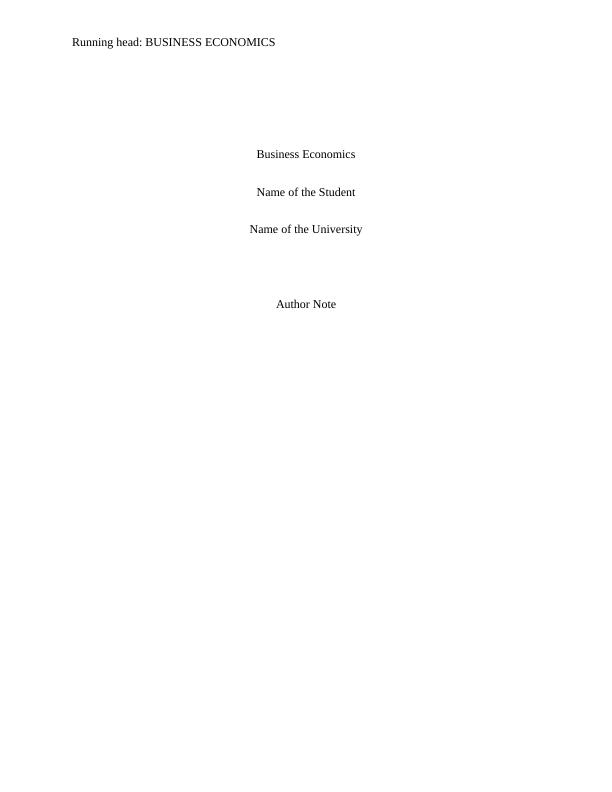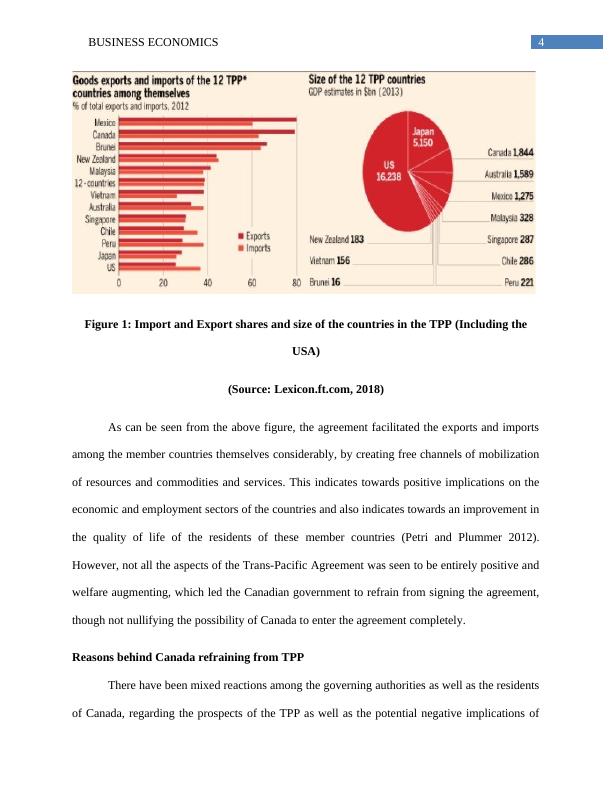Introduction to Trans-Pacific Partnership 3 Reasons behind Canada refraining from TPP
Added on 2020-05-16
25 Pages4404 Words73 Views
Running head: BUSINESS ECONOMICS Business EconomicsName of the StudentName of the UniversityAuthor Note

1BUSINESS ECONOMICS Table of ContentsPart 1................................................................................................................................................2Introduction..................................................................................................................................2Trans-Pacific Partnership.............................................................................................................3Reasons behind Canada refraining from TPP..............................................................................4A) Impacts of TPP on automobile industry if Canada does not participate................................6B) Impacts of TPP on automobile industry if Canada participates...........................................11Part 2..............................................................................................................................................16Section 2.1.................................................................................................................................16Section 2.2.................................................................................................................................18Section 2.3.................................................................................................................................19References......................................................................................................................................21

2BUSINESS ECONOMICS Part 1 Introduction Over the last few decades, the global commercial framework has undergone considerabledynamics, much of which can be attributed to global phenomena like Globalization andLiberalization in the industrial and commercial sectors of different countries. With theinternational trade scenario becoming more integrating and inclusive and with resources as wellas goods services moving across different countries much freely, the demand and supply scenarioin the markets have changed extensively (Salvatore and Brooker 2015). To facilitate such easytrades and movements of resources as well as commodities, many countries have entered intovaried types of Trade Agreements. These agreements commonly have the objectives of reducingthe barriers that exist in the path of productive commercial activities of the countries, therebyfacilitating the economic growth of all the member countries (Baier, Bergstrand and Mariutto2014). Keeping this into consideration, one of the most significant international agreements,which have attracted huge global attention, in the contemporary global trade and politicalscenario is that of the Trans-Pacific Partnership. The Trans-Pacific Partnership, which wasinitially signed in February 2016, by twelve of the world,’s leading economies which border thePacific Ocean. Together these twelve countries amount to nearly 40% of the total GDP of theworld and have considerable influence on the global industrial, commercial and employmentsector. However, in the recent period, the USA has walked out of the agreement, making it aneleven countries agreement (Bbc.com, 2018).

3BUSINESS ECONOMICS However, according to the latest development, Canada has not confirmed its participationin the agreement, as the Prime Minister of the country has not been able to agree to the terms ofthe Trans-Pacific Agreement. This is primarily because he felt that the terms and conditions ofthe agreements needed to be modified to make it fit for the increase in the welfare of bothCanada, as well as the world as a whole. Considering this, the report tries to analyze the effectsof the agreement on both Canada as well as the rest of the member countries, in the conditionwhere Canada participates in the agreement and in the condition where it does not (Blatchford2018). To study the impacts of the same, the report emphasizes on the automobile industry ofCanada and the other member countries, as the same is one of the industries which are expectedto have significant implications of the TPP. Trans-Pacific Partnership As discussed above, the Trans-Pacific Partnership had been primarily designed with theobjective of fostering closer and more productive economic and commercial relationships amongthe member countries, thereby facilitating the growth of the economies of all the membercountries. The main aim of the project was to reduce or nullify the import and export tariffs andto relax the other restrictions and regulations, which previously existed in these aspects such thatimports and exports become cheap and all the countries get chances to explore different markets,thereby growing economically (Williams 2013).

4BUSINESS ECONOMICS Figure 1: Import and Export shares and size of the countries in the TPP (Including theUSA)(Source: Lexicon.ft.com, 2018)As can be seen from the above figure, the agreement facilitated the exports and importsamong the member countries themselves considerably, by creating free channels of mobilizationof resources and commodities and services. This indicates towards positive implications on theeconomic and employment sectors of the countries and also indicates towards an improvement inthe quality of life of the residents of these member countries (Petri and Plummer 2012).However, not all the aspects of the Trans-Pacific Agreement was seen to be entirely positive andwelfare augmenting, which led the Canadian government to refrain from signing the agreement,though not nullifying the possibility of Canada to enter the agreement completely. Reasons behind Canada refraining from TPP There have been mixed reactions among the governing authorities as well as the residentsof Canada, regarding the prospects of the TPP as well as the potential negative implications of

5BUSINESS ECONOMICS the agreement on the overall economy as well as on its residents. The main aspects in which theconfusions exit regarding the implication of the same on the country are as follows: Figure 2: Opinions of Canadians regarding the prospects and the drawbacks of the TPP(Source: Asiapacific.ca, 2018)As can be seen from the above figure, showing the opinions of the Canadian residentsregarding the positive and negative implications of the TPP, there exists considerable confusionsregarding the aspects of higher wages, income equality, competitiveness of local businesses,labor standards and environmental aspects of the country, under the operational framework of theTrans-Pacific Partnership (Cook 2017). Keeping this into consideration, the following sections of the project tries to take intoaccount the impact of the TPP on the chosen automobile industry of Canada as well as othercountries, A) If Canada refrains from participating in the TPP and B) If Canada participates in

End of preview
Want to access all the pages? Upload your documents or become a member.
Related Documents
Assignment - Trans Pacific Partnership (TPP)lg...
|9
|1833
|94
NAFTA and Trans-Pacific Partnership: Impact on Member Countrieslg...
|14
|3816
|163
Managerial Economics in Global Environmentlg...
|12
|4175
|27
Article on Annotated Bibliography 2022lg...
|4
|853
|43
Issues in Global Businesslg...
|8
|2341
|464
International Trade between Australia and New Zealandlg...
|29
|7550
|121
